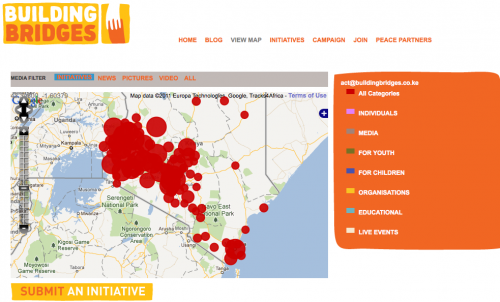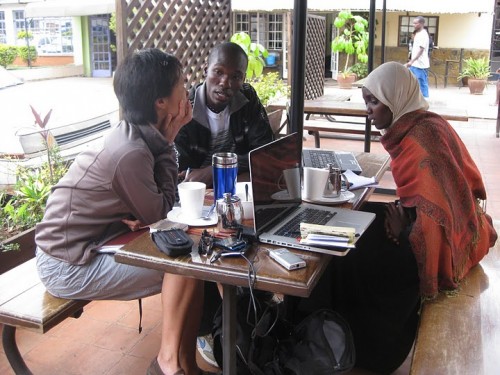Preparations for the Ushahidi .ke Evaluation launch are running full speed ahead. Jennifer Chan, Harvard Humanitarian Initiative and I visited Rukia Sebit and Tobias Ouma of MamaBits, the coordinators of Building Bridges deployment. Building Bridges is a project to encourage people to encourage, map and connect people working on peace initiatives in Kenya. Their work was one of the featured deployments for the evaluation.
[caption id="attachment_5020" align="aligncenter" width="500" caption="Building Bridges"] [/caption]
Rukia and Tobias provided further feedback on their deployment: successes, observations and things to improve.
[/caption]
Rukia and Tobias provided further feedback on their deployment: successes, observations and things to improve.

 [/caption]
Rukia and Tobias provided further feedback on their deployment: successes, observations and things to improve.
[/caption]
Rukia and Tobias provided further feedback on their deployment: successes, observations and things to improve.

Highlights:
- OUTREACH: Communication targeting of audiences differed for rural and urban areas and diverse age groups. For example, rural areas were reached by radio rather than newspaper. However, the radio programs were sometimes aired in different vernacular language to accommodate all listeners. The impact was great, even neighbouring countries such as Uganda received the information from the website and created their profile online. This required more intensive report verification based on location. The power of mobile in .ke is amazing. Telco providers like Safaricom will allow short codes to accompany hash-tags which will redirect to a website, like Building Bridges. The campaign was successful due to the SMS program and pervasive use in .ke.
- REPORTS: As part of the campaign, the Building Bridges team telephoned over 6000 people. These calls were often to verify the content or to request clarification. Some content was translated into English for the map from telephone calls. Some reports were web-based submissions in Swahili. It would have been useful to have a bilingual map: Swahili and English. People who filed reports often required feedback or follow-up on their content. These involved counselor-type telephone calls. This community approach was essential to build comfort and trust. Some report providers preferred that their content be provided verbally and their report listed by "peacemaker" to maintain their privacy. The majority of the reports were submitted via SMS with the other reports far below in numbers (in descending order): telephone calls, email and, lastly, web-based form reports.
- KEY LESSONS: The plan was revised to accommodate more SMS reports (sometimes 700 a day). Education (digital literacy) was a large component of the telephone calls for feedback loops. The number targets were given less weight over time in lieu of qualitative content and relationship-building with the reporters. And, this type of project is easily replicable in other regions using Ushahidi's platform.